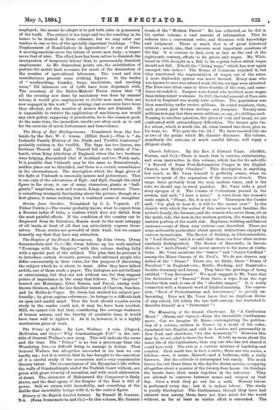History of the English Landed Interest. By Russell M. Gamier,
B.A. (Swan Sonnenschein and Co.)—In this volume, Mr. Gamier treats of the "Modern Period." He has collected, as he did in his earlier volume, a vast amount of information. This he reduces into a convenient order, and discusses with knowledge and judgment. There is much that is of great historical interest ; much, also, that concerns most important questions of the day. It is curious to find, even as late as the end of the eighteenth century, efforts to fix prices and wages. Mr. Whit- bread in 1795 brought in a Bill to fix a point below which wages should not fall. Behold the " living wage," which has now again emerged into notice I The House of Commons rejected it, but they sanctioned the augmentation of wages out of the rates. A more deplorable system was never devised. Every man who was known to save was refused work till his savings were absorbed. The Poor-rate often came to three-fourths of the rent, and some- times exceeded it. Paupers were found who received more wages than independent workmen. In 1817, the total amount of Poor-rate levied in England was nearly eight millions. The population was then something under twelve millions. In round numbers, then, each person paid thirteen shillings and fourpence. Twenty-nine millions now pay less than seven millions, or, say, five shillings each Turning to another question, the price of corn and bread, we are confronted with extraordinary difficulties. The farmer gets 14s. fcr wheat, which is worth 22s. 2d. when turned into flour, plus 4s. for bran, &c. Who gets the 12s. 2d. ? We have touched but one or two of the points which Mr. Gamier discusses. His volume, manifestly the outcome of much careful labour, will repay a diligent study.






































 Previous page
Previous page